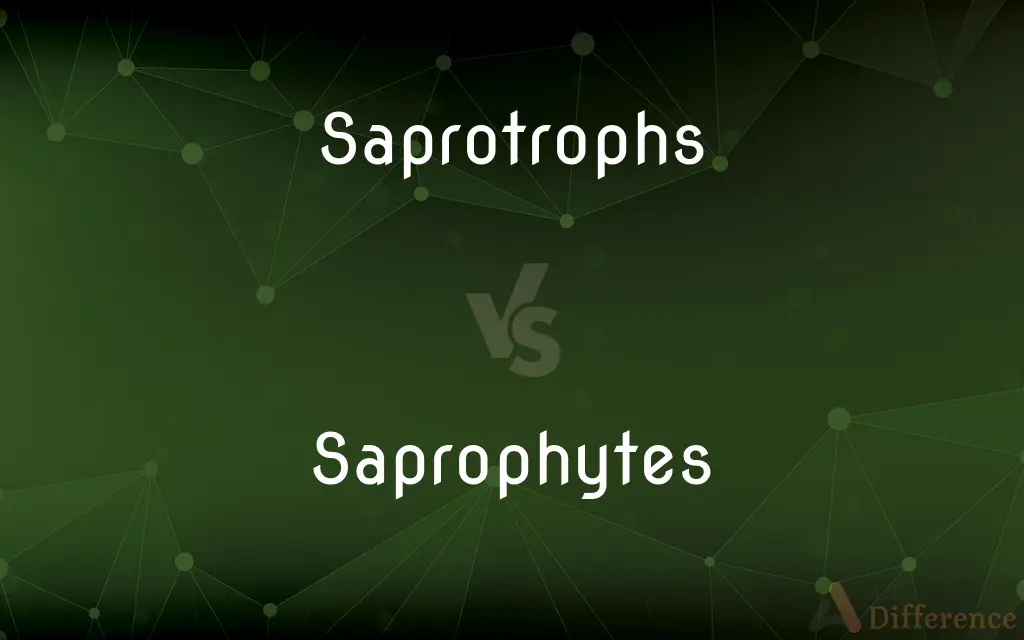Saprotrophs vs. Saprophytes — What's the Difference?
By Tayyaba Rehman — Published on October 20, 2023
Saprotrophs are organisms that decompose and absorb nutrients from organic matter externally. Saprophytes, often used interchangeably, specifically refer to plants, but this term is largely outdated as most decomposers are fungi, not plants.

Difference Between Saprotrophs and Saprophytes
Table of Contents
ADVERTISEMENT
Key Differences
Saprotrophs: This term represents a diverse group of organisms, primarily fungi and bacteria, that play a critical role in decomposition. By secreting enzymes, saprotrophs break down complex organic matter externally and then absorb the released nutrients. The ecological role of saprotrophs is vital as they recycle organic material, making nutrients available to other organisms.
Saprophytes: Historically, this term was used to describe plants that obtained nutrients from decaying organic matter. However, as our understanding evolved, it became clear that true plants are rarely, if ever, saprophytic. Most of the organisms previously termed "saprophytes" are fungi. Hence, the term has become somewhat obsolete in modern botanical and ecological discussions.
Nutritional Methods: Both saprotrophs and saprophytes are involved in the breakdown of dead and decaying organic matter. The difference lies primarily in the terminology and the organisms they traditionally referred to. Saprotrophs use enzymatic decomposition and then absorb nutrients, while "saprophytes," in outdated usage, would have indicated a plant deriving nutrition from decayed matter.
Terminological Evolution: It's essential to understand how language evolves in science. Saprotrophs is a more inclusive and accurate term, acknowledging the primary role fungi and bacteria play in decomposition. On the other hand, saprophytes, being plant-centric, doesn't capture the ecological reality accurately.
Ecological Importance: Both terms underscore the critical ecological role these organisms play in nutrient cycling. Whether called saprotrophs or saprophytes, these decomposers ensure that nutrients locked in dead organisms are returned to the environment, supporting life's continuity.
ADVERTISEMENT
Comparison Chart
Organisms Typically Referred
Primarily fungi and bacteria
Historically referred to certain plants
Nutritional Method
External enzymatic decomposition and absorption of nutrients
(Historically) Obtained nutrients from decaying matter
Modern Usage
Widely accepted and used
Largely outdated due to misconceptions about plant decomposers
Role in Ecology
Decomposition and nutrient cycling
Conceptually similar but refers specifically to plants
Associated with Plants?
No, primarily fungi and bacteria
Yes, but inaccurately as true plants aren't typically saprophytic
Compare with Definitions
Saprotrophs
Organisms relying on the absorption of dissolved organic nutrients.
Saprotrophs ensure that energy and nutrients in dead organisms don't go to waste.
Saprophytes
Historically used term for plants thought to thrive on decaying organic substances.
Over time, the understanding of saprophytes has been corrected to primarily involve fungi.
Saprotrophs
Organisms that feed on decomposed matter through external digestion.
Fungi, as saprotrophs, play a vital role in breaking down dead wood.
Saprophytes
Entities believed to feed on decomposed organic material without photosynthesis.
It's a misconception that saprophytes represent a common plant lifestyle.
Saprotrophs
Decomposers that release enzymes to break down organic material externally.
Leaf litter in forests is decomposed by saprotrophs, recycling nutrients.
Saprophytes
Organisms, traditionally thought to be plants, deriving nutrition from decaying matter.
In older literature, certain fungi were mistakenly labeled as saprophytes.
Saprotrophs
Entities that facilitate organic matter decomposition through enzymatic action.
Soil fertility is, in part, maintained by the actions of saprotrophs.
Saprophytes
Organisms obtaining sustenance from dead and decayed organic material.
The term saprophytes was often used in early botanical studies before the role of fungi was fully understood.
Saprotrophs
Key players in the nutrient cycle by recycling dead and decaying matter.
Without saprotrophs, ecosystems would be burdened with undecomposed organic material.
Saprophytes
A somewhat outdated term suggesting plants feeding on decomposed matter.
Modern ecology recognizes that what were called saprophytes are usually fungi or bacteria.
Saprotrophs
Plural of saprotroph
Saprophytes
An organism, especially a fungus or bacterium, that derives its nourishment from dead or decaying organic matter. Also called saprobe.
Saprophytes
Plural of saprophyte
Common Curiosities
Why is the term saprophytes considered outdated?
It inaccurately suggested certain plants were decomposers, but most are actually fungi.
Do saprotrophs perform photosynthesis?
No, saprotrophs derive nutrients from decomposed matter, not through photosynthesis.
Can a plant be a saprotroph?
True plants typically aren't saprotrophs, though some form associations with saprotrophic fungi.
How do saprotrophs obtain their nutrients?
They release enzymes to break down organic matter externally and absorb the resulting nutrients.
Are saprotrophs and saprophytes the same thing?
No, saprotrophs include fungi and bacteria, while saprophytes historically referred to certain plants.
Were mushrooms ever considered saprophytes?
Yes, but it's more accurate to classify most mushrooms as saprotrophic fungi.
How do saprotrophs aid in soil fertility?
By decomposing organic matter, saprotrophs release nutrients back into the soil.
Why might one see the term saprophytes in older literature?
Earlier, the role of fungi was less understood, leading to plants being mistakenly labeled as saprophytes.
Are all fungi saprotrophs?
Many fungi are saprotrophs, but not all; some are mutualistic or parasitic.
Are saprotrophs essential for ecosystems?
Yes, they play a vital role in decomposition and nutrient cycling.
How do saprotrophs and saprophytes contribute to the carbon cycle?
By decomposing organic matter, they release carbon back into the environment.
Why is the role of saprotrophs ecologically critical?
They ensure efficient nutrient cycling, supporting plant growth and overall ecosystem health.
Do saprophytes still exist?
The term is outdated; what were once considered saprophytic plants are now understood as fungi or associated organisms.
Did saprophytes ever actually refer to true plants?
Rarely. The term was based on misconceptions; most organisms fitting the description are fungi.
How has the understanding of saprotrophs and saprophytes evolved?
Modern science recognizes the primary role of fungi and bacteria in decomposition, moving away from plant-centric terms like saprophytes.
Share Your Discovery

Previous Comparison
Monopoly vs. Monopolistic Competition
Next Comparison
Tense vs. ParticipleAuthor Spotlight
Written by
Tayyaba RehmanTayyaba Rehman is a distinguished writer, currently serving as a primary contributor to askdifference.com. As a researcher in semantics and etymology, Tayyaba's passion for the complexity of languages and their distinctions has found a perfect home on the platform. Tayyaba delves into the intricacies of language, distinguishing between commonly confused words and phrases, thereby providing clarity for readers worldwide.
















































